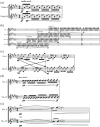Alpha oscillations related to self-other integration and distinction during live orchestral performance: A naturalistic case study
- PMID: 36532616
- PMCID: PMC9751440
- DOI: 10.1177/03057356221091313
Alpha oscillations related to self-other integration and distinction during live orchestral performance: A naturalistic case study
Abstract
Ensemble music performance requires musicians to achieve precise interpersonal coordination while maintaining autonomous control over their own actions. To do so, musicians dynamically shift between integrating other performers' actions into their own action plans and maintaining a distinction between their own and others' actions. Research in laboratory settings has shown that this dynamic process of self-other integration and distinction is indexed by sensorimotor alpha oscillations. The purpose of the current descriptive case study was to examine oscillations related to self-other integration and distinction in a naturalistic performance context. We measured alpha activity from four violinists during a concert hall performance of a 60-musician orchestra. We selected a musical piece from the orchestra's repertoire and, before analyzing alpha activity, performed a score analysis to divide the piece into sections that were expected to strongly promote self-other integration and distinction. In line with previous laboratory findings, performers showed suppressed and enhanced alpha activity during musical sections that promoted self-other integration and distinction, respectively. The current study thus provides preliminary evidence that findings from carefully controlled laboratory experiments generalize to complex real-world performance. Its findings also suggest directions for future research and potential applications of interest to musicians, music educators, and music therapists.
Keywords: EEG; alpha oscillations; ensemble music performance; joint action; naturalistic case study; self-other integration and distinction.
© The Author(s) 2022.
Conflict of interest statement
The author(s) declared no potential conflicts of interest with respect to the research, authorship, and/or publication of this article.
Figures



Similar articles
-
Simultaneous self-other integration and segregation support real-time interpersonal coordination in a musical joint action task.Acta Psychol (Amst). 2021 Jul;218:103348. doi: 10.1016/j.actpsy.2021.103348. Epub 2021 May 28. Acta Psychol (Amst). 2021. PMID: 34058671
-
Musical and Bodily Predictors of Mental Effort in String Quartet Music: An Ecological Pupillometry Study of Performers and Listeners.Front Psychol. 2021 Jun 28;12:653021. doi: 10.3389/fpsyg.2021.653021. eCollection 2021. Front Psychol. 2021. PMID: 34262504 Free PMC article.
-
Neural alpha oscillations index the balance between self-other integration and segregation in real-time joint action.Neuropsychologia. 2016 Aug;89:414-425. doi: 10.1016/j.neuropsychologia.2016.07.027. Epub 2016 Jul 20. Neuropsychologia. 2016. PMID: 27449708
-
Collaborative Musical Creativity: How Ensembles Coordinate Spontaneity.Front Psychol. 2018 Jul 24;9:1285. doi: 10.3389/fpsyg.2018.01285. eCollection 2018. Front Psychol. 2018. PMID: 30087645 Free PMC article. Review.
-
Why do we need to investigate non-classical musicians to reduce the burden of musicians' musculoskeletal symptoms?Ind Health. 2020 Jun 9;58(3):212-223. doi: 10.2486/indhealth.2019-0094. Epub 2019 Oct 5. Ind Health. 2020. PMID: 31588069 Free PMC article. Review.
Cited by
-
A practical guide to EEG hyperscanning in joint action research: from motivation to implementation.Soc Cogn Affect Neurosci. 2024 May 10;19(1):nsae026. doi: 10.1093/scan/nsae026. Soc Cogn Affect Neurosci. 2024. PMID: 38584414 Free PMC article. Review.
References
-
- Adler S. (2002). The study of orchestration (3rd ed.). Norton.
-
- Babiloni C., Babiloni F., Carducci F., Cincotti F., Cocozza G., Del Percio C., Moretti D. V., Rossini P. M. (2002). Human cortical electroencephalography (EEG) rhythms during the observation of simple aimless movements: A high-resolution EEG study. NeuroImage, 17(2), 559–572. 10.1006/nimg.2002.1192 - DOI - PubMed
-
- Bazanova O. M., Gvozdev A. V., Mursin F. A., Verevkin E. G., Shtark M. B. (2003). EEG-EMG dimensionality of the musical performance. Cognitive Processing, 4(3), 33–47.
LinkOut - more resources
Full Text Sources
